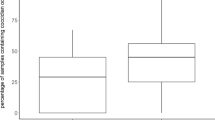Abstract
The ability to resist infections can differ between individuals of different social rank. This study investigates if the clearance of an avian virus infection (Sindbis virus) was related to the social status of greenfinches (Carduelis chloris) and if infected birds would decline in social status. The results showed that virus clearance patterns were related to social status. Within groups of birds with similar plumage color (a social status signal), body mass and age, a bird’s social status could be used to predict virus clearance patterns. Dominant birds had higher virus concentrations early in the infection and lower virus titres during later stages of the infection as compared to birds that were subordinates. The infection had no significant effect on previously established social ranks, and ranks that were established during the infection did not appear to be influenced by a bird’s infection status. In conclusion, this study exemplifies a case where the social rank of an individual was a predictor of the ability to clear a viral infection. The underlying physiological mechanisms of this relationship remain to be further investigated.


Similar content being viewed by others
References
Biron CA (1999) Initial and innate responses to viral infections- pattern setting in immunity or disease. Curr Opin Microbiol 2:374–381
Buchner A, Erdfelder E, Faul F (1997) How to use G-Power. http://www.psycho.uni-duesseldorf.de/aap/projects/gpower/how_to_use_gpower.html. Cited 6 October 2003
Buchanan K (2000) Stress and the evolution of condition-dependent signals. Trends Ecol Evol 15:156–160
Chamberlain RW, Sudia WD (1961) Mechanisms of transmission of viruses by mosquitoes. Annu Rev Entomol 6:371.390
Cramp S, Perrins CM (1994) The birds of the western Palearctic, vol 8. Oxford University Press, Oxford
Creel, S (2001) Social dominance and stress. Trends Ecol Evol 16:491–497
Earley E, Peralta PH, Johnson KM (1967) A plaque neutralization method for arboviruses. Proc Soc Exp Biol Med 125:741–747
Ekman J, Hake MK (1990) Monitoring starvation risk: adjustments of body reserves in greenfinches (Carduelis chloris L.) during periods of unpredictable food supply. Behav Ecol 1:62–67
Eley C (1991) Status signalling in the western greenfinch, Carduelis chloris. PhD thesis, University of Sussex, Brighton, U.K.
Evans MR, Goldsmith AR, Norris SRA (2000) The effect of testosterone on antibodyproduction and plumage coloration in male house sparrows (Passer domesticus). Behav Ecol Sociobiol 47:156–163
Folstad I, Karter AJ (1992) Parasites, bright males, and the immunocompetence handicap. Am Nat 139:603–622
Francy DB, Jaenson TGT, Lundström JO, Schildt E-B, Espmark Å, Henriksson B, Niklasson B (1989) Ecologic studies of mosquitoes and birds as hosts of Ockelbo virus in Sweden and isolation of Inkoo and Batai viruses from mosquitoes. Am J Trop Med Hyg 41:355–363
Freeland WJ (1981) Parasitism and behavioral dominance among male mice. Science 213:461–462
Hake M (1996) Fattening strategies in dominance-structured greenfinch (Carduelis chloris) flocks in winter. Behav Ecol Sociobiol 39:71–76
Hamilton WD, Zuk M (1982) Heritable true fitness and bright birds: a role for parasites? Science 218:384–387
Klasing KC (1998) Nutritional modulation of resistance to infectious diseases. Poult Sci 77:1119–1125
Lindström KM, Lundström JO (2000) Male greenfinches with brighter ornaments have higher virus infection clearance rates. Behav Ecol Sociobiol 48:44–51
Lindström KM, Krakower DS, Lundström JO, Silverin B (2001) The effect of testosterone on a viral infection in greenfinches (Carduelis chloris): an experimental test of the immunocompetence handicap hypothesis. Proc R Soc Lond B 268:1–5
Lindström KM, van der Veen IT, Lundström JO, Legault B-A (2003) Activity and predator escape performance of Greenfinches infected with Sindbis virus. Ardea 91:103–111
Lundström JO (1999) Mosquito-borne viruses in Western Europe: a review. J Vect Ecol 24:1–39
Lundström JO, Niklasson B, Francy BD (1990) Swedish Culex torrentium and Cx. pipiens (Diptera: Culicidae) as experimental vectors of Ockelbo virus. J Med Entomol 27:561–564
Merilä J, Sheldon BC, Lindström K (1999) Plumage brightness in relation to hematozoan infections in the Greenfinch, Carduelis chloris: bright males are a good bet. Ecoscience 6:1-7
Niklasson B, Espmark Å, Lundström J (1988) Occurrence of arthralgia and specific IgM antibodies three to four years after Ockelbo disease. J Infect Dis 157:832–835
Norder H, Lundström JO, Kozuch O, Magnius LO (1996) Genetic relatedness of Sindbis virus strains from Europe, Middle East and Africa. Virology 222:440-445
Olson VA, Owens IPF (1998) Costly sexual signals: are carotenoids rare, risky or required? Trends Ecol Evol 13:510–514
Poiani A, Goldsmith AR, Evans MR (2000) Ectoparasites of house sparrows (Passer domesticus): an experimental test of the immunocompetence handicap hypothesis. Behav Ecol Sociobiol 47:230–242
Pusey AE, Packer C (1997) The ecology of relationships. In: Krebs JR, Davies NB (eds) Behavioural ecology an evolutionary approach, 4th edn. Blackwell, Cambridge, pp 254–284
Qvarnström A, Forsgren E (1998) Should females prefer dominant males? Trends Ecol Evol 13:498–501
Rohwer S (1975) The social significance of avian plumage variability. Evolution 29:593–610
Saks L, Ots I, Horak P (2003) Carotenoid-based plumage coloration of male greenfinches reflects health and immunocompetence. Oecologia 134:301–307
Senar JC (1990) Agonistic communication in social species: what is communicated? Behaviour 112:270–283
Wingfield JC, Hegner RE, Dufty AM, Ball GF (1990) The “challenge hypothesis”: theoretical implications for patterns of testosterone secretion, mating systems, and breeding strategies. Am Nat 136:829–846
Zuk M, Johnsen TS (2000) Social environment and immunity in the red jungle fowl. Behav Ecol 11:146–153
Zuk M, Kim T, Robinson SI, Johnsen TS (1998) Parasites influence social rank and morphology, but not mate choice, in female red junglefowl, Gallus gallus. Anim Behav 56:493–499
Acknowledgements
J. Lundström, I. Ahnesjö, M. Zuk, A. Qvarnström and J. Höglund provided constructive discussions when planning this experiment, and/or gave valuable comments on the manuscript. The experiment was approved by the ethical committee of animal research (C216/96) in Uppsala and animals were maintained in accordance with the laws regulating animal care in Sweden.
Author information
Authors and Affiliations
Corresponding author
Additional information
Communicated by C. Brown
Rights and permissions
About this article
Cite this article
Lindström, K.M. Social status in relation to Sindbis virus infection clearance in greenfinches. Behav Ecol Sociobiol 55, 236–241 (2004). https://doi.org/10.1007/s00265-003-0703-3
Received:
Revised:
Accepted:
Published:
Issue Date:
DOI: https://doi.org/10.1007/s00265-003-0703-3




